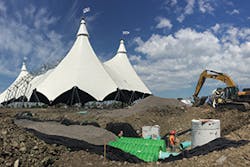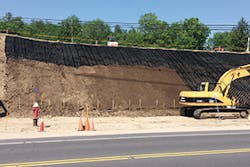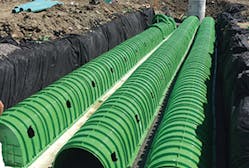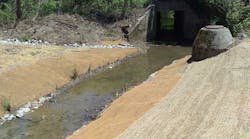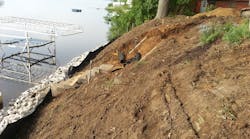Geosynthetics often play a starring role in a variety of applications: drainage, cellular confinement systems, green roofs, pond liners, covers for closed and capped landfills, and reinforcement for retaining walls, among others.
Alton Bay
In a 2017 slope stabilization project on a roadway widening in Alton Bay, NH, costs and aesthetics were major considerations in choosing a solution.
Widening of a road around the south end of Lake Winnipesaukee in Alton Bay created a steep 1-to-1 slope adjacent to the roadway. Concerns that potential erosion and washout would occur during heavy rain events made stabilization necessary.
“We had a very steep slope of 48 feet in height that we had to move back 44 feet to the edge of the road, because we were working in somebody else’s property and we had to get a slope easement for that,” says Ken Roberts, highway manager for the city of Alton Bay.
After considering a block retaining wall at a cost of $60,000 and Presto Geosystems’ GEOWEB slope system for $14,000, the city decided on GEOWEB—a geocell system made from high-density polyethylene—based both on cost savings and on design and installation support, notes Roberts.
Local distributor EJ Prescott worked with Presto’s design team to create a detailed specification. The GEOWEB cells were filled with topsoil and hydroseeded to ensure full grass coverage.
The installation was completed by a crew from the town’s highway department, which installed 10,000 square feet of the product on the slope within a day and a half, notes Roberts.
“When we put the GEOWEB in, the slope was so steep we had to rappel it,” he says. “You couldn’t walk on the face of it. I have guys that have qualifications in that, and I do too. We rappelled down over it and hooked up all of the ATRA clips.”
Once the product was in place, though, he says, “I walked right up over the face. Before that, it was such a loose, granular material that you couldn’t walk up the face—it just kept sliding down. After the GEOWEB was in place, you could walk right up it just like you were walking up a set of stairs. No slipping, no sliding. I was totally amazed with the product.”
Roberts notes that the only problem the crews encountered was that heavy rains caused some erosion, although not related to the GEOWEB itself.
“I went three inches higher with the topsoil, and before I could get the stuff stabilized, we had the rains,” he says.
Within four weeks, the slope was fully vegetated with dense grass, with no damage or infill loss despite the challenge of multiple storm events hitting the area before it was fully vegetated.
Another goal of the project was to regain parking, notes Roberts.
“We have 4,800 full-time residents and we grow to 18,000 to 22,000 in the summer,” he says. “I have 89 miles of road, and this was one of the projects to increase parking within the Alton Bay area, which is a hub—everything goes on in the bay. We increased the parking there to 44 spots. That’s phenomenal for a town this small.”
Roberts says that although this was his first experience with GEOWEB, he would consider using it in future projects.
“I’ve had a lot of contractors talking with me about it because of the low cost and the end result,” he says. “I have an ‘A’ crew—guys who you instruct once. You don’t stand there and hold their hand; you get out of their way and they do the work.
“When they were done and the grass was growing on the slope, I planted wild flowers on it; I’ve had nothing but compliments about the whole project, including that. I’ve had no less than six different big contractors within the state call and discuss it with me. We know it’s a system that works here in New England.”
Fixing the Trail
The public works department of Laguna Niguel, CA, was challenged with a drainage and erosion issue at a popular walking trail in a public park. The trail, which traverses a sizeable slope, was prone to ongoing damage and erosion from water runoff.
The captured runoff had previously been directed to a point where it was dissipated with sandbags and riprap before entering a surface inlet leading to a drain pipe; however, the inlet frequently clogged with sediment and debris.
Alton Bay Park
In addition to solving the drainage issues, the public works employees also wanted to reconfigure the inlet with a more substantial and long-term solution that would allow for sediment collection, permitting cleaner runoff to flow into the drainage pipe.
The erosion damage to the trail and the constant need to replace rotting sandbags led to a significant amount of annual maintenance, which was necessary to prevent flooding into the residential neighborhood downslope of and adjacent to the park.
Another challenge was the public park’s remote and confined road access. The department sought a cost-effective solution that could be easily deployed with minimal construction equipment, because access to the work site would not have been possible with oversized equipment such as a cement truck.
After considering options, the department determined that Milliken Infrastructure’s Concrete Cloth geosynthetic cementitious composite mat (GCCM) would meet the project requirements and demands. Concrete Cloth is designed to be installed in the rain and other wet conditions. The material is available in three thicknesses—5, 8, and 13 millimeters—and in two formats: bulk rolls and small batch rolls.
Concrete Cloth material is designed with a low alkaline reserve and a low wash rate for minimal ecological impact. The fabric can be hung vertically, laid in trenches, or cut and formed into shapes.
The initial task on the project was to reverse the pitch of the trail to divert drainage away from the edge of the trail toward the toe of the slope. Following this minor regrade, a V-gutter cut in a trapezoidal design to allow easier cleaning of sediment with a shovel was dug along the upslope side of the trail to capture the newly diverted trail runoff as well as the shear water flows coming from the slope to three inlet locations.
After the trail was compacted and graded to meet the specifications of the newly required pitch, crews installed Concrete Cloth in the V-gutter using an adhesive and screws where panels overlapped. The cloth was secured to the ground with anchors.
Anchoring trenches were dug parallel to the flow line of the trapezoidal drains on the upslope side so that the Concrete Cloth could be buried into the slope, preventing future undermining of the ditches.
The Concrete Cloth material was delivered with a pickup truck. Crews used two bulk rolls totaling 5,436 square feet and seven batch rolls totaling 7,623 square feet of CC5, the 5-millimeter-thick version, which was enough to cover the 2,746 linear feet of V-gutter throughout the park.
To hydrate the newly installed Concrete Cloth, a 500-gallon water tank was brought in on a pickup truck.
Installation of the stormwater chambers
Following installation, crews converted the inlets—previously made with stone and sandbags—to more permanent structures. Around the inlet basins, sediment capture areas were hand-dug and then covered and secured with the same CC5 Concrete Cloth GCCM at a level below the entrance of the inlets to collect sediment.
Additionally, gravel bags placed on the slopes for runoff dissipation were overlaid with Concrete Cloth material, increasing the durability and permanence of these structures.
The project took place in March 2017 using a crew of five workers from a local city-approved contracting company, E. Stewart and Associates.
The project also eliminated much of the annual maintenance requirements while making post-storm cleanups safer and easier.
Ready for the Show
Cavalia, an entertainment company specializing in artistic equestrian and acrobatic techniques, had a major show—Odysseo—scheduled to premier in Mississauga, ON, during the summer of 2017.
In advance of the show, site work was necessary on a 10-acre parcel of city-owned land. Cavalia was responsible for construction of an event pad on the site. However, before it could be completed, other site work was needed, including installation of a subsurface stormwater system. The system would need to store 138 cubic meters of runoff within the developed site, and it needed to be installed quickly so that Cavalia crews could finish preparing for the show, which was only three weeks away.
Working with Pacific Paving, Cavalia, and the city of Mississauga, Terrafix Geosynthetics designed and supplied a stormwater system from Triton Stormwater Solutions. The system consists of chambers made from a soy resin-based polymer, designed to be lighter, larger, and stronger than conventional chambers. The system had a footprint of 5.5 by 26.3 meters and was 1.68 meters deep. The trench into which the chambers were placed was lined with nonwoven geosynthetic material and crushed stone.
Installation of the Triton system—which included excavation, stone placement, installation of chamber components, and backfill—was completed in less than a week, giving the Cavalia crew time to prepare for the premiere.
A total of 90 S-29 chambers were installed in three rows of 30. Located in the property’s storage and equipment area, the Triton system was designed to be capable of withstanding traffic loading from the crew’s vehicles.
